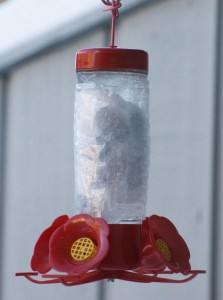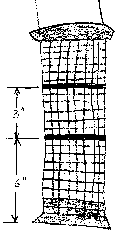© Calvin May
Feeding hummingbirds in freezing temperatures
Brandon Green, of Eugene, Oregon, talked to a local birder about keeping hummingbird feeders from freezing. The birder recommended a ThermaCare pad. Brandon sent us a picture of his prototype and wrote, “This is the first incarnation (I wrapped the next day’s feeder with two pads and a heavier layer of bubble wrap). It’s good for at least two hours at temperatures in the low 20’s, and then the uncovered bottom section will begin to freeze. (That’s enough time to get the hummers their “morning jolt” of energy. We usually repeat the process in the mid/late afteroon.)”
Tallying tip
“To keep track of my bird counts, I bought a dry erase board (with a magnet back so it can stay on the fridge). Using a permanent marker, I made a list of my most commonly sighted species–with a separate line for temperature and precipitation. The permanent marker will not erase. I keep my totals on the board with a dry erase marker. It’s super easy to wipe off and change numbers. All I have to do is take the board to the computer after each set of Count Days to enter my data.” –Suzanne Kozloskie, Long Branch, New Jersey
Slinky™ squirrel baffle
“One of the posts that holds feeders in my yard sports a Slinky™, which is the most effective squirrel guard that I have ever seen.” –E. F. Wood, Clifton, New Jersey
“We have a regular squirrel population. However, they only have access to the ground seed and one tube feeder. We were able to outwit them this season by attaching slinkies to two poles and suspending a thin wire between the poles[see diagram].It really worked. The squirrels are baffled by the slinky movement.” –Jessica Kaminsky, West Hempstead, New York
Feeding birds on a fire escape
Karen Konicki wanted to feed birds from her apartment building fire escape in New York City. However, the neighbors complained about her tube feeder because they believed the falling seeds were attracting rats. It turned out that the rats weren’t being attracted by her feeder, but by the time her feeder was cleared of blame, she had created a new feeder that she liked better. She described her creative process as follows.
“I took a wooden foot stool, and turned it upside down. The underside was like a tray with which to hold the seeds. To keep the Mourning Doves and pigeons out, I put green fencing around the legs and over the top. Initially, I had pretty wide openings, and the Mourning Doves could easily get in. When I saw a starling sail right through the box, some additional “tweaking” with the makeshift feeder was required. I ran twine across the openings, making them smaller. An occasional Mourning Dove still sneaks in, but not often. I tied the feeder to the fire escape to secure it. It took some time for the birds to figure out the new feeder, hence I had a lower than normal bird count for awhile. But now they pretty much empty the tray of seeds everyday,” said Karen.
Feeder inches
John Wright wrote from Chesterfield, Missouri, to tell us how he distinguishes his Hairy Woodpeckers from his Downy Woodpeckers.
“For the past 2 years, I have been trying to tell a Downy Woodpecker from a Hairy Woodpecker. They frequent a peanut feeder that is about fifty feet from my viewing point. Some birds seem larger than others, but I could never be sure–even when looking through binoculars. Finally I got smart. When I brought the feeder in to clean it, I wrapped two rings of bright green tape around it. One ring is exactly 6″ up from the bottom, and the second ring is 3″ above the first ring. (See sketch at right.) Now when the birds come to feed I can better estimate their size. For two years I have been reporting only Downys. Now, I know for sure there are also Hairys,” wrote John.